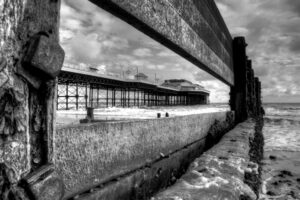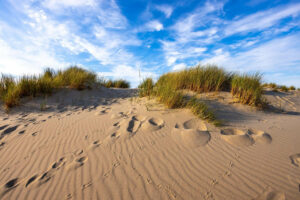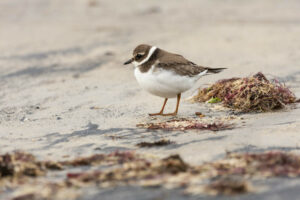Aggregates Role In Coastal Defence
Coastal erosion is a real problem in some areas of the UK. In particular parts of the Norfolk and Suffolk coastline are in constant threat of crumbling away. So how are we trying to stop this from happening and what are the aggregates role in coastal defence?
Hardscape Solutions.
Traditionally we have gone down the hardscape route such as sea walls. Although this has done what it set out to do, it has had a negative impact on the natural environment. They may prevent erosion but they also prevent sediment release from the cliffs which reduces beach levels. These sometimes ugly measures have made these areas less attractive to us, wildlife and vegetation. These structures are expensive and therefore are only viable in small areas. This often means that the problem is just pushed along to other areas. The cost of on-going repairs is also an issue with this type of defence.

Groynes are probably the most expensive measure to put in place.
They are designed to create and maintain a healthy beach which protects the land behind. Groynes need to be installed in groups known as a groyne field to be effective. Acting as a barrier to prevent sediment being transported away, which causes a build-up of beach on one side of the groyne. A series of groynes interrupts the tidal flow forcing the tidal current further offshore beyond the groyne end. This causes a slower inshore tidal current which encourages the depositing of sediment on the beach. These are also the option with the highest repair and maintenance costs.
Revetments are another traditional method of helping with coastal erosion.
They can be permeable or impermeable. They cost less than a sea wall and are more commonly made from timber. These timber structures absorb the waves energy and as such the impact on the cliffs. As sediment can get trapped behind these which can be deposited on the beach these are better for beach levels and further protect the cliff base. These generally carry high maintenance costs and are not suitable for all sites.
So moving forward we are starting to see a new approach to coastal protection. Let’s have a look at the aggregates role in coastal defence and what these are in more depth.
Natural Solutions And The Aggregates Role In Coastal Defence.
These are becoming a more favoured approach as they offer many benefits beyond just coastal defence. These can include anything from restoring tidal habitats to creating artificial reefs.
Sandscaping
This has been used in Norfolk on the Bacton to Walcott Coastline to raise the height and width of the beach to absorb the sea forces before they reach the cliffs. It is hoped that this sand placement will, over time, benefit biodiversity. This type of construction also has had little impact on existing wildlife and their habitat.
Dune Regeneration
Another natural option that includes either building up existing or creating new dunes. Combining fencing and planting vegetation to strengthen and protect the dunes from human activity help to create a natural buffer from storms and support wildlife.

Beach Renourishment
Beach Renourishment such as that at Clacton involves large quantities of sand or shingle being added to the existing beaches. This creates a much wider sloping beach which in turn will reduce the destructive impact of the sea as they cause the waves to break earlier and lose energy before they reach the cliffs.
Breakwaters and Artificial Reefs
Placing heavy aggregate stones in large quantities to create breakwaters and artificial reefs is another approach being taken to help combat sea damage. These natural structures are designed to reduce the force of the waves and protect the shoreline. They are also providing new habitats and minimise the environmental impact some sea defence solutions have.
Rock Armour
Used at Happisburgh they allow the water to flow around these large aggregate rocks causing the waves to release energy. This means that when the wave reaches the foot of the cliff its impact is greatly reduced. More attractive than a concrete sea wall it is also good for the natural environment and creating new habitats.
What’s more if acquired from quarries with easy access to a port these aggregates can easily be transported to the areas required, saving on long road transportation.
Using Ai For Coastal Defence
Along with these natural solutions the use of AI is helping to monitor, scale and calculate the success of these strategies. Going forward combining the effectiveness of AI data and this ecological sea defence approach will help preserve our coasts and add to the enjoyment of them.
Norfolk and Suffolk Showing The Way Forward
There are currently several groundbreaking coastal defence programs in place in Norfolk and Suffolk which are using 1000s of tonnes of aggregates to help create a natural and more sustainable protection for our coast. With hundreds of thousands of homes, businesses and historic sites at risk it is increasingly important to face this issue head on and find ways to protect our shores.
Why Use Local Quarries for the aggregates role in coastal defence?
The other advantage of using local quarries such as Middleton Aggregates to supply the sand or stone is that they may have the same or complementing materials that will enhance or have little impact on the look of the area. The correct placement of aggregates for sea defence is proving to be an attractive, effective and economical choice.
Of course aggregates aren’t the only answer but they do and are providing a more natural one.
Natural Solutions To Enhance Our Coasts
We are beginning to accept that holding the line as far as our coast is concerned is an increasingly difficult mission. However by using these more natural solutions in the areas we really need to protect and just letting nature do its thing in others we could end up with an even better coastline in the future. One that is full of biodiversity with areas better suited for human recreation and supporting wildlife.

If you are concerned about the risks from coastal erosion in Norfolk and Suffolk you can use these links for more information.
Property at risk from Coastal Erosion North Norfolk